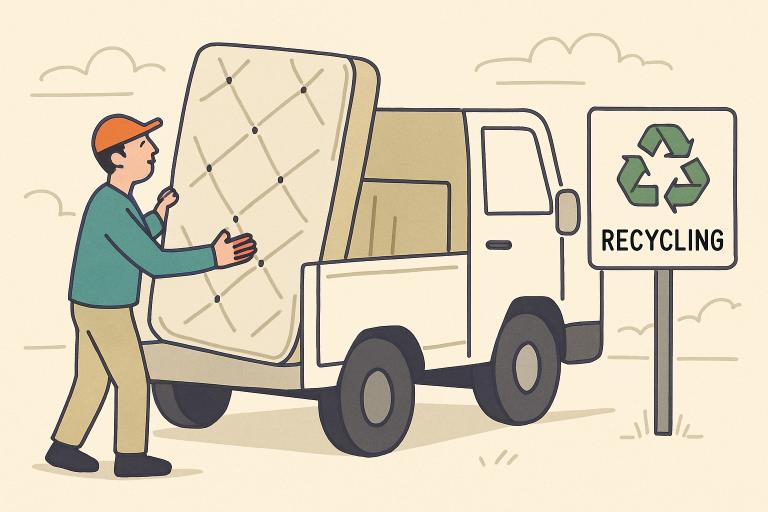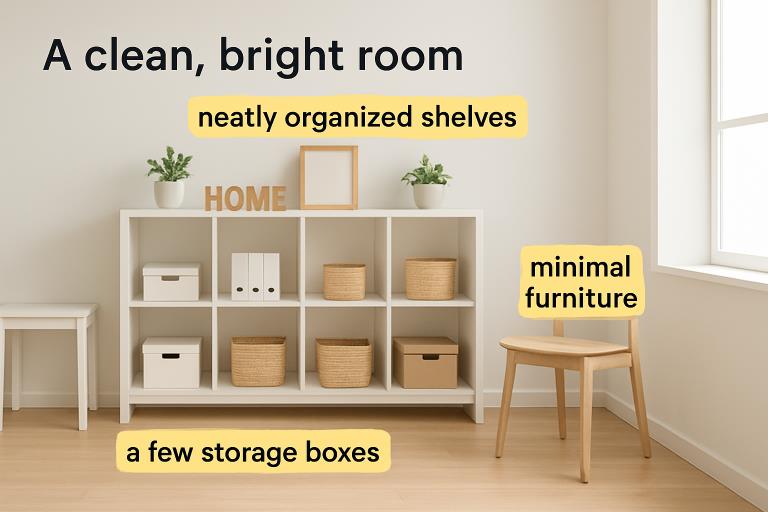Now Reading: A Step-by-Step Guide to Recycling Your Mattress Responsibly
-
01
A Step-by-Step Guide to Recycling Your Mattress Responsibly
A Step-by-Step Guide to Recycling Your Mattress Responsibly

Key Takeaways
- By recycling a mattress, we are conserving resources, reducing landfill waste, and supporting a sustainable environment, which is particularly important in our disposable culture.
- Donating a mattress is appropriate if it is in good condition, especially if someone can use it, but when it is damaged or worn out, then, it may be unsafe to reuse, and recycling the mattress may be best for the environment and the public.
- You may need to locate a local facility to recycle the mattress or check with the retailer from whom you purchased the mattress to see if they can provide a take-back option, which makes it easier to recycle mattress materials responsibly.
- Depending on the facility, if you take preliminary actions to get the mattress ready for recycling or donating, or are aware of the facility options, the process should be relatively simple and lead to proper recycling and recovery of valuable materials and other product usages.
Why Recycle Your Mattress?
Every year, millions of mattresses are thrown in landfill and taking up a lot of space and harming our planet. Mattresses are large, difficult to biodegrade, and take up nearly 40 cubic ft, or 4.2 cubic yards (more than one ton) of landfill per mattress.* In the process of decomposing, mattresses can leach volatile organic compounds (VOCs) and other toxics into the environment and add to waste management problems. That being said, mattresses are made up of many recyclable materials (steel springs, polyurethane foam, wood frames, fabric covers,) and can often be reused for re-manufacturing. Mattress disposal allows you to not only free up some valuable space in your home, but also to significantly reduce the landfill footprint of your mattress, as well as impact your emissions and limited natural resources.
Many states and municipalities have been passing or implementing laws/programs for mattress stewardship that provide the public with an opportunity to recycle their mattresses and sometimes mandate mattress recycling. These laws/programs benefit from statistics provided by organizations such as the Mattress Recycling Council, which report that up to 80% of mattress materials can be repurposed into new products. The mattress materials can become carpet underlay, insulation, mulch, or industrial filters, all of which are indications of recycling and sustainable re-manufacturing, both environmentally and economically. Every mattress recycled, contributes directly to a healthier more stable planet, and creates savings for local communities against potentially rising disposal costs.
Step 1: Assess the Condition of Your Mattress
Before you begin plans for disposal, be sure to carefully evaluate the condition of your mattress. If it is of age (under eight years), does not have any significant sagging or broken coils, and has no signs of stains, mold, or odors, then donating your mattress is worth considering. Many local charities, shelters, and reuse centers are always looking for gently used bedding for those who are starting over or who are currently classified as homelessness. Not only does this minimize waste, it benefits members of your community who are in need.
On the contrary, if your mattress is obviously worn out— persistent sagging, significant stains from spills or accidents, actual tearing, or even worse, any evidence of active pests such as bed bugs or fleas—then your mattress is not suitable for donation. These issues often represent too much risk for recipients and waste handlers. When in doubt, recycling is the best route if there are any of these issues. Never attempt to donate a mattress that suffers from sanitary or structural issues. Most charities will refuse compromised items due to health and liability issues.
Step 2: Locate a Mattress Recycling Facility
Thanks to advancements in municipal disposal and focused recycling companies, you will now be able to contribute to the recycling of mattresses easily. The starting point is with reputable online directories, such as Earth911.com, which help you find a mattress recycling facility by entering your ZIP code. Several states, including California, Connecticut, and Rhode Island, have enacted mattress recycling laws that will allow most residents to easily recycle their mattresses.
Another great resource is your city or county’s waste management department—check their website for events or drop-off locations. In rural or less populated areas, some private junk removers or moving companies are offering mattress recycling for a minimal fee, too. The junk part will transport your mattress to a certified recycling facility directly, helping you protect your time and save time recycling responsibly.
Step 3: Prepare Your Mattress for Recycling
Preparation is vital to provide a hassle-free recycling process and minimize contamination risk:
- Remove all Bedding: To prep the mattress, remove all bedding (pillows, protectors, toppers) and set aside anything that can be reused or recycled separately. Only the bare mattress and box spring (if applicable) can be processed for recycling.
- Make Sure It’s Clean: The best mattress you can recycle is the one that is clean and as dry as possible. Do not attempt to recycle any mattresses that are heavily soiled, water damaged or infested with bugs. These circumstances can lead to equipment harm, create unsanitary working conditions and the loss of reusable materials.
- Bag the Mattress: Some mattress recyclable facilities require the mattress to be placed in some type of large plastic bag or cover to protect the mattress from dirt and bugs. Be sure to ask ahead of time for their policies — typically, you can buy bags at moving supply stores, large retailers or the recycling facility itself. Following these procedures, not only helps the recycling location but also prevents cross contamination of other mattresses or recyclable materials.
Step 4: Arrange Transportation
How to get your mattress to the recycling facility will depend on your location and local programs. If you live in a city or suburb, your local city hall may allow you to drop off your mattress, or it could pick up through a bulk waste service.
Typically, it is easier and cheaper to recycle through these services than to rent a truck or van, especially if you do not own a vehicle.
If you are responsible for transportation, just make sure it is safe and legal (some people just rent a van or ask a friend with a truck). If transportation on foot will not work, then the recycling center and/or a junk removal service may pick up on your doorstep. The cost is usually $20-$75 depending on distance. Be sure to confirm that you are getting picked up, how much it will cost, and your expectations of what they’ll need from you when they arrive for pickup.
Step 5: Understand the Recycling Process
Recycling mattresses involves the following processes, which are all carried out to ensure a high recovery rate of each material.
- Disassembly – In this stage, trained technicians cut the mattress open and remove it from the fabric cover, disassembling the mattress into its main types of material; metal springs or coils, foam padding, wooden frame, and textile fiber. This laborious task is performed to allow for sorting the specific material effectively and efficiently so that it can be processed and resale or reused.
- Sorting – After being taken apart, the materials are sorted into their materials; steel coils are sorted from the wood slats, foam, and fabric. Each of these categories goes through a different recycling process.
- Processing – Each material that is sorted goes through a wash and processing stage. Steel gets melted and is used as raw material in new appliances, vehicles, or infrastructure. Foam can be shredded and reused as padding in carpet, upholstery, or even insulation in new homes. Wood is chipped to be sent for landscaping mulch or energy recovery, and textile fiber is also sent to be reused into new textiles for industry. This “closed-loop” approach maintains materials in use and out of landfills, but also eliminates the constant need to use new raw materials, as well as decreases emissions and environmental effects of production.
Closed loop is essential to creating the culture of a circular economy where materials are recycled and continually integrated back into the manufacturing process.
Alternative Options: Retailer Take-Back Programs
Buying a new mattress is usually a great time to take advantage of retailer take-back programs to dispose of the old mattress in an eco-responsible way. Most retail mattress sales companies, as well as many online, direct-to-consumer brands, now have an option for the delivery team to take your old mattress away for recycling, either for a nominal fee, or usually complimentary when purchasing a new product. This option can be an especially convenient option for consumers without access to a vehicle, or the good fortune of extra time to manage the disposal of a spent mattress. Additionally, and maybe most importantly, this relationship ensures that those old mattresses are being recycled properly, usually partnering with tangibly certified (e.g., an certifications) recycling companies able to process the materials in compliance with local laws and environmental regulations.
Additionally, many of the industry’s leading manufacturers have a strong commitment to green initiatives, and take their responsibilities seriously at the end of a product lifecycle. When shopping for a new bed, make sure to ask about take-back programs, product produced from recycled materials, partnerships with recycling organization, or certifications—many retailers proudly display their efforts as part of their environmental mission. Overall, this effort makes disposal easier for consumers, while still advancing the mattress industry toward a circular economy.
Final Thoughts
Recycling your mattress is one of the simplest and most effective things you can do to improve your own sustainability and create a healthier environment. This includes assessing the state of your mattress; finding a viable recycling facility; prepping your mattress; arranging for transportation and, when it comes your turn, how the mattress recycling process works, to name a few. Simply following the steps to recycling a mattress keeps valuable materials recycled and out of the local landfills. If you have the chance to replace, keep your act of sustainability in mind, to find products (via the manufacturer) to support take-back programs and sustainable values. Overall when all of these individual acts are combined, real change can occur while minimizing future waste generation and conserving natural resources long-term.




















